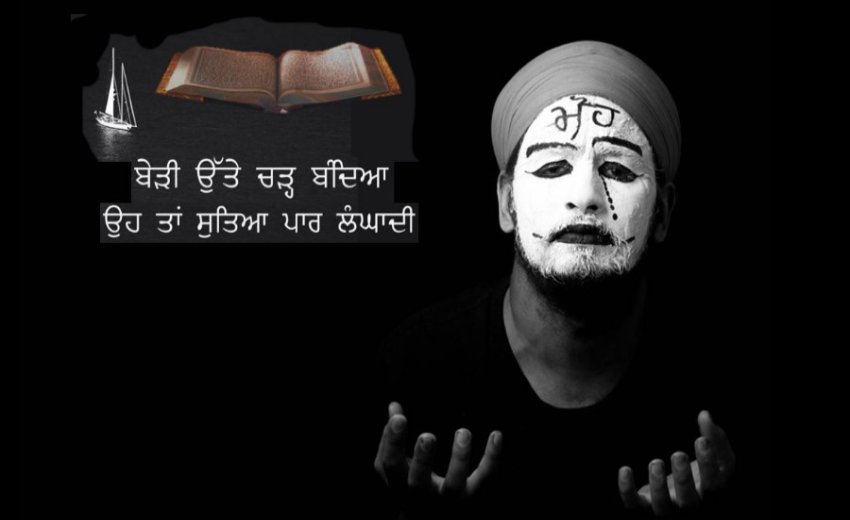Concept of Maya in Sri Guru Granth Sahib
Hardev Singh Virk
Abstract
Maya is one of the most complicated concepts of Indian philosophy. It is a pillar of Hindu philosophy, known as Advaita Vedanta. Maya appears in all religious traditions of India. It has different connotations in Hinduism, Buddhism and Sikh religion. Advaita Vedanta considers Brahman (God) as the only Reality and all His creation as illusion or Maya. Guru Nanak transforms the Vedantic concept of Reality in Sri Guru Granth Sahib (SGGS) and proclaims that this universe is also real, not an illusion. A detailed study of Maya concept in Sikh religion is presented based on the writings of Sikh Gurus in the SGGS and its implications for the Indian society.
Introduction
The concept of Maya is beautifully explained by the metaphor of rope appearing as a snake in dim light. Maya created a phenomenon of appearance of rope for snake in dim light, which is the result of ignorance created by our mind. In the bright light, the misconception and fear is gone with true knowledge of rope. Maya flourishes in ignorance and disappears with the rise of enquiry leading to true knowledge. Maya is not real; it is only an illusion power of the Supreme consciousness. Just like the shadow which is always present with us, Maya always exists in the Supreme Being.
Sikhism is classified as an Indian religion along with Buddhism, Hinduism and Jainism. Guru Nanak (1469-1539) is the founder of Sikh religion. The basis of Sikhism lies in the teachings of Guru Nanak and his nine successor Gurus. The Sikh scripture, Sri Guru Granth Sahib (SGGS) was compiled by Guru Arjun Dev in 1604 and is considered as the only authentic holy book in the world which includes the sacred writings of 6 Sikh Gurus, 15 Indian Saints and 15 other contributors.
According to Guru Nanak [1] the supreme purpose of human life is to reconnect with Akal (The Timeless One), however, egotism is the biggest barrier in doing this. Māyā, defined as a temporary illusion or "unreality", is one of the core deviations from the pursuit of God and salvation: where worldly attractions which give only illusory temporary satisfaction and pain which distract the process of the devotion to God. However, Nanak emphasised Māyā as not a reference to the unreality of the world, but of its values. Sikhs believe the world is currently in a state of kali yuga ('age of darkness') because the world is led astray by the love of attachment to Maya [2].
Concept of Maya in Sri Guru Granth Sahib
The term Maya occurs 827 times in SGGS under various connotations, for example, illusion, ignorance, serpent, magic, falsehood and delusion. For sake of illustration, we may give quotes from the SGGS in support of our definition of Maya as follows:
Maya as an Illusion [3]:
ਬਾਬਾ ਮਾਇਆ ਭਰਮਿ ਭੁਲਾਇ ॥
Bābā mā▫i▫ā bẖaram bẖulā▫e.
O Baba, Maya deceives with its illusion.
Maya as Delusion [4]:
ਮਾਈ ਮਾਇਆ ਛਲੁ ॥ਤ੍ਰਿਣ ਕੀ ਅਗਨਿ ਮੇਘ ਕੀ ਛਾਇਆ ਗੋਬਿਦ ਭਜਨ ਬਿਨੁ ਹੜ ਕਾ ਜਲੁ ॥
O my mother, Maya is so misleading and deceptive. Without meditating on the Lord of the Universe, it is like straw on fire, or the shadow of a cloud, or the running of the flood-waters.
Maya as female-serpent (nagin) [5]:
ਮਾਇਆ ਹੋਈ ਨਾਗਨੀ ਜਗਤਿ ਰਹੀ ਲਪਟਾਇ ॥
Mā▫i▫ā ho▫ī nāgnī jagaṯ rahī laptā▫e.
Maya is a serpent, clinging to the world.
ਇਸ ਕੀ ਸੇਵਾ ਜੋ ਕਰੇ ਤਿਸ ਹੀ ਕਉ ਫਿਰਿ ਖਾਇ ॥
Is kī sevā jo kare ṯis hī ka▫o fir kẖā▫e.
Whoever serves her, she ultimately devours.
Maya as ignorance leads to spiritual darkness [6]:
ਮਾਇਆ ਮੋਹੁ ਅਗਿਆਨੁ ਹੈ ਬਿਖਮੁ ਅਤਿ ਭਾਰੀ ॥
Mā▫i▫ā moh agi▫ān hai bikẖam aṯ bẖārī.
Emotional attachment to Maya is spiritual darkness; it is very difficult and such a heavy load.
In SGGS, concept of Maya has been used in two different contexts: temporal and spiritual.
Maya is a necessary ingredient for leading a worldly life. It denotes wealth and other worldly possessions of man. The economic structure of the society is based upon Maya (wealth). It plays a significant role in all spheres of human activity, including religion and politics. For leading a trouble-free life, Maya is a necessary evil.
Guru Arjun in a hymn of SGGS beautifully describes the human predicament as both the excess and lack of Maya are dangerous [7]:
ਜਿਸੁ ਗ੍ਰਿਹਿ ਬਹੁਤੁ ਤਿਸੈ ਗ੍ਰਿਹਿ ਚਿੰਤਾ ॥ਜਿਸੁ ਗ੍ਰਿਹਿ ਥੋਰੀ ਸੁ ਫਿਰੈ ਭ੍ਰਮੰਤਾ ॥
Jis garihi bahuṯ ṯisai garihi cẖinṯā. Jis garihi thorī so firai bẖarmanṯā.
The household which is filled with abundance - that household suffers anxiety.
One whose household has little, wanders around searching for more.
ਦੁਹੂ ਬਿਵਸਥਾ ਤੇ ਜੋ ਮੁਕਤਾ ਸੋਈ ਸੁਹੇਲਾ ਭਾਲੀਐ ॥੧॥
Ḏuhū bivasthā ṯe jo mukṯā so▫ī suhelā bẖālī▫ai. ||1||
He alone is happy and at peace, who is liberated from both conditions.
Guru Nanak has emphatically stated that Maya cannot be amassed without using sinful means and exploitation of society but it never goes with the man after his death [8]:
ਇਸੁ ਜਰ ਕਾਰਣਿ ਘਣੀ ਵਿਗੁਤੀ ਇਨਿ ਜਰ ਘਣੀ ਖੁਆਈ ॥
Is jar kāraṇ gẖaṇī viguṯī in jar gẖaṇī kẖu▫ā▫ī.
For the sake of this wealth, so many were ruined; and so many have been disgraced.
ਪਾਪਾ ਬਾਝਹੁ ਹੋਵੈ ਨਾਹੀ ਮੁਇਆ ਸਾਥਿ ਨ ਜਾਈ ॥
Pāpā bājẖahu hovai nāhī mu▫i▫ā sāth na jā▫ī.
It was not gathered without sin, and it does not go along with the dead.
In Sikh religion, Guru Nanak and other Sikh Gurus laid the foundation of Sikh society on three pillars:
1. Kirat Karni: earning an honest living to support the family;
2. Vand Chhakna: sharing one's earnings with others who need and giving to charity.
3. Naam Japna: keeping God in mind at all times; meditation on qualities of God.
So generation of wealth is not forbidden in Sikh religion but it has to be earned by honest means and needs to be shared with those who are deprived of wealth and prosperity.
It is a big paradox that Maya which is the cause of separation of man from its divine source, is created by God Himself [9]:
ਰੰਗੀ ਰੰਗੀ ਭਾਤੀ ਕਰਿ ਕਰਿ ਜਿਨਸੀ ਮਾਇਆ ਜਿਨਿ ਉਪਾਈ ॥
Rangī rangī bẖāṯī kar kar jinsī mā▫i▫ā jin upā▫ī.
He created the world, with its various colors, species of beings, and the variety of Maya.
Creation of Universe by God is a phenomenon based on Maya [10]:
ਨਿਰੰਕਾਰਿ ਆਕਾਰੁ ਉਪਾਇਆ ॥ ਮਾਇਆ ਮੋਹੁ ਹੁਕਮਿ ਬਣਾਇਆ ॥
Nirankār ākār upā▫i▫ā. Mā▫i▫ā moh hukam baṇā▫i▫ā.
The Formless Lord created the universe of form.
By the Hukam of His Command, He created attachment to Maya.
Sikhism believes that people are trapped in the world because of five vices: lust, anger, greed, attachment, and ego.
Maya enables these five vices and makes a person think the physical world is "real," whereas, the goal of Sikhism is to rid the self of them.
Guru Amardas defines functions of Maya and how it traps the man in egotism [11]:
ਮਾਇਆ ਕਿਸ ਨੋ ਆਖੀਐ ਕਿਆ ਮਾਇਆ ਕਰਮ ਕਮਾਇ ॥
Mā▫i▫ā kis no ākẖī▫ai ki▫ā mā▫i▫ā karam kamā▫e.
What is called Maya? What does Maya do?
ਦੁਖਿ ਸੁਖਿ ਏਹੁ ਜੀਉ ਬਧੁ ਹੈ ਹਉਮੈ ਕਰਮ ਕਮਾਇ ॥
Ḏukẖ sukẖ ehu jī▫o baḏẖ hai ha▫umai karam kamā▫e.
These beings are bound by pleasure and pain; they do their deeds in egotism.
Guru Arjun describes another strange characteristic of Maya. Those who love it are left in the lurch but those who abandon it and do not bother about Maya, it falls at their feet [12]:
ਗਹੁ ਕਰਿ ਪਕਰੀ ਨ ਆਈ ਹਾਥਿ ॥ ਪ੍ਰੀਤਿ ਕਰੀ ਚਾਲੀ ਨਹੀ ਸਾਥਿ ॥
Gahu kar pakrī na ā▫ī hāth. Parīṯ karī cẖālī nahī sāth.
No matter how hard you try to grab it, it does not come into your hands.
No matter how much you may love it, it does not go along with you.
ਕਹੁ ਨਾਨਕ ਜਉ ਤਿਆਗਿ ਦਈ ॥ਤਬ ਓਹ ਚਰਣੀ ਆਇ ਪਈ ॥੧॥
Kaho Nānak ja▫o ṯi▫āg ḏa▫ī. Ŧab oh cẖarṇī ā▫e pa▫ī. ||1||
Says Nanak, when you abandon it, then it comes and falls at your feet. ||1||
Philosophically thinking, there seems some correspondence between Hindu concept of Maya and its counterpart in Sikh religion. However, on the basis of empirical considerations, there are basic differences among the two. Sikh religion does not consider abnegation of Maya as a human virtue.
Salvation can be achieved by living a fruitful life amidst Maya [13]:
ਏਹ ਮਾਇਆ ਜਿਤੁ ਹਰਿ ਵਿਸਰੈ ਮੋਹੁ ਉਪਜੈ ਭਾਉ ਦੂਜਾ ਲਾਇਆ ॥
Ėh mā▫i▫ā jiṯ har visrai moh upjai bẖā▫o ḏūjā lā▫i▫ā.
This is Maya, by which God is forgotten; emotional attachment and love of duality well up.
ਕਹੈ ਨਾਨਕੁ ਗੁਰ ਪਰਸਾਦੀ ਜਿਨਾ ਲਿਵ ਲਾਗੀ ਤਿਨੀ ਵਿਚੇ ਮਾਇਆ ਪਾਇਆ ॥੨੯॥
Kahai Nānak gur parsādī jinā liv lāgī ṯinī vicẖe mā▫i▫ā pā▫i▫ā. ||29||
Says Nanak, by Guru's Grace, those who enshrine love for the Lord find Him, in the midst of Maya. ||29||
A person entrenched in Maya and its influence is known as Mayadhari in Sikh parlance. Such persons are called blind and deaf in SGGS [14]:
ਮਾਇਆਧਾਰੀ ਅਤਿ ਅੰਨਾ ਬੋਲਾ ॥ ਸਬਦੁ ਨ ਸੁਣਈ ਬਹੁ ਰੋਲ ਘਚੋਲਾ ॥
Mā▫i▫āḏẖārī aṯ annā bolā. Sabaḏ na suṇ▫ī baho rol gẖacẖolā.
One who is attached to Maya is totally blind and deaf. He does not listen to the Word of the Shabad; he makes a great uproar and tumult.
SGGS indicates the methodology to get out of maya-meshes of worldly life created by Maya. One has to focus his mind on the Shabad of SGGS to get rid of ill effects of Maya. Meditation on the Name of God and living the life of a Gurmukh helps the Sikh to win over the ill-effects of Maya [15, 16]:
ਗੁਰ ਕੈ ਸਬਦਿ ਰਿਦੈ ਦਿਖਾਇਆ ॥ਮਾਇਆ ਮੋਹੁ ਸਬਦਿ ਜਲਾਇਆ ॥
Gur kai sabaḏ riḏai ḏikẖā▫i▫ā. Mā▫i▫ā moh sabaḏ jalā▫i▫ā.
Through the Word of the Guru's Shabad, the Lord is seen within one's own heart.
Through the Shabad, I have burned my emotional attachment to Maya.
ਨਿਰਮਲ ਨਾਮੁ ਵਸਿਆ ਮਨਿ ਆਏ ॥ ਮਨੁ ਤਨੁ ਨਿਰਮਲੁ ਮਾਇਆ ਮੋਹੁ ਗਵਾਏ ॥
Nirmal nām vasi▫ā man ā▫e. Man ṯan nirmal mā▫i▫ā moh gavā▫e.
When the Immaculate Naam comes to dwell in the mind, the mind and body become Immaculate, and emotional attachment to Maya departs.
What is unique contribution of Sikh religion to concept of Maya in the Indian philosophy? In Hindu philosophy, development of concept of Maya and its interpretation gets transformed from Vedic period to Advaita Vedanta, which considers Brahman (God) as the only Reality and all His creation as illusion or Maya. The founder of Sikh religion, Guru Nanak, was always antipathetic to any view of the world, which denigrated its reality or made the world illusory. He was, therefore, firm on the principle that the creation is as real as the creator -- it includes, besides material existence, the culture of man, his thoughts and his values. Guru Nanak discards the Vedantic conception of Reality in Asa-di-Var, and proclaims that this universe is real, not an illusion [17]:
ਸਚੇ ਤੇਰੇ ਖੰਡ ਸਚੇ ਬ੍ਰਹਮੰਡ ॥ ਸਚੇ ਤੇਰੇ ਲੋਅ ਸਚੇ ਆਕਾਰ ॥
Sacẖe ṯere kẖand sacẖe barahmand. Sacẖe ṯere lo▫a sacẖe ākār.
Real are Thy continents; Real is the universe;
Real are these forms and material objects;
Thy doings are Real, O Lord.
Guru Nanak calls this world as real because this vast universe is abode of the True Lord [18]:
ਇਹੁ ਜਗੁ ਸਚੈ ਕੀ ਹੈ ਕੋਠੜੀ ਸਚੇ ਕਾ ਵਿਚਿ ਵਾਸੁ ॥
Ih jag sacẖai kī hai koṯẖ▫ṛī sacẖe kā vicẖ vās.
This moving universe is the divine mansion of the true Lord;
And the True One lives therein.
In Sikh religion, the world is regarded as both transitory and relatively real. God is viewed as the only reality, but within God exist both conscious souls and non-conscious objects; these created objects are also real [19].
Natural phenomena are real but the effects they generate are unreal. Māyā is, as the events are real yet, Māyā is not, as the effects are unreal.
However, in SGGS, Māyā refers to the "grand illusion" of materialism. From this Māyā all other evils are born, but by understanding the nature of Māyā a person begins to approach spirituality. Most people are believed to suffer from the false consciousness of materialism, which leads to worldly entanglements [20, 21]:
ਬਾਬਾ ਮਾਇਆ ਰਚਨਾ ਧੋਹੁ ॥ਅੰਧੈ ਨਾਮੁ ਵਿਸਾਰਿਆ ਨਾ ਤਿਸੁ ਏਹ ਨ ਓਹੁ ॥੧॥
Bābā mā▫i▫ā racẖnā ḏẖohu. Anḏẖai nām visāri▫ā nā ṯis eh na oh. ||1||
O Baba, the splendor of Maya is deceptive. The blind man has forgotten the Name;
he is in limbo, neither here nor there. ||1||
ਬਿਨੁ ਹਰਿ ਅਵਰੁ ਨ ਆਵਸਿ ਕਾਮਾ ਝੂਠਾ ਮੋਹੁ ਮਿਥਿਆ ਪਸਾਰੇ ॥੧॥
Bin har avar na āvas kāmā jẖūṯẖā moh mithi▫ā pasāre. ||1|| rahā▫o.
Without the Lord, nothing else shall be of use to you; false is emotional attachment, and useless are worldly entanglements. ||1||
In some mythologies the symbol of the snake was associated with money and Māyā in modern Punjabi refers to money. In SGGS, Bhagat Ravidas uses the Vedantic metaphor of 'the rope mistaken for a snake', to understand the mystery of this universe [22]:
ਰਾਜ ਭੁਇਅੰਗ ਪ੍ਰਸੰਗ ਜੈਸੇ ਹਹਿ ਅਬ ਕਛੁ ਮਰਮੁ ਜਨਾਇਆ ॥
Rāj bẖu▫i▫ang parsang jaise hėh ab kacẖẖ maram janā▫i▫ā.
Like the story of the rope mistaken for a snake, the mystery has now been explained to me.
([email protected])
--------------------------------------------
References:






